Developing Learning Analytics Frameworks for Institutions

Understanding Learning Analytics: What It Is and Why It Matters
Learning analytics refers to the measurement, collection, analysis, and reporting of data about learners and their contexts. This practice helps institutions understand how students learn and how they can improve their educational practices. By leveraging data, schools can enhance student engagement and retention, ultimately leading to better academic outcomes.
Data-driven decision-making is the cornerstone of improving educational outcomes.
The significance of learning analytics lies in its potential to provide actionable insights. For instance, by analyzing student performance data, educators can identify struggling students early and offer targeted interventions. This proactive approach not only supports at-risk learners but also fosters a culture of continuous improvement within the institution.
Moreover, understanding the learning patterns of students allows institutions to tailor their educational offerings. For instance, if data reveals that a particular course consistently underperforms, educators can reassess the curriculum or teaching methods. This iterative process ensures that educational practices are aligned with student needs and learning objectives.
Key Components of a Learning Analytics Framework
A robust learning analytics framework consists of several key components, including data sources, analytics tools, and reporting mechanisms. Institutions must identify where their data will come from, such as learning management systems, assessments, and student feedback. This foundational step is crucial for creating a comprehensive picture of the educational landscape.

Next, selecting the right analytics tools is essential for processing and interpreting the collected data. Tools can vary from simple dashboards to advanced machine learning algorithms that can predict student success. The choice of tools should align with the institution's goals and the specific insights they wish to gain from their data.
Learning Analytics Enhances Education
By analyzing data on student performance, institutions can identify areas for improvement and tailor educational practices to better meet student needs.
Finally, effective reporting mechanisms are needed to communicate findings to stakeholders, including educators, administrators, and students. Clear, actionable reports can guide decision-making and foster a data-informed culture within the institution. By making data accessible and understandable, institutions empower all stakeholders to participate in the learning improvement process.
Establishing Clear Goals for Learning Analytics Implementation
Before diving into the technical aspects, institutions must establish clear goals for their learning analytics initiatives. These goals should be specific, measurable, achievable, relevant, and time-bound (SMART). For example, an institution might aim to reduce dropout rates by 15% within two academic years through targeted interventions based on analytics data.
Without data, you're just another person with an opinion.
Setting goals not only provides direction but also helps in evaluating the success of the analytics framework. Regularly revisiting these goals allows institutions to adapt to changing educational landscapes and student needs. This flexibility is vital in ensuring that the analytics framework remains relevant and effective over time.
Additionally, involving faculty and stakeholders in the goal-setting process fosters buy-in and collaboration. When educators understand how learning analytics can directly impact their teaching and student outcomes, they are more likely to engage with the data. This collaborative approach creates a shared vision for learning analytics within the institution.
Data Privacy and Ethical Considerations in Learning Analytics
As institutions collect and analyze student data, prioritizing data privacy and ethical considerations is paramount. Institutions must ensure compliance with regulations like FERPA (Family Educational Rights and Privacy Act) to protect student information. This responsibility goes beyond legal compliance; it also builds trust between students and the institution.
In addition to legal requirements, ethical considerations include being transparent with students about what data is collected and how it is used. Communicating the benefits of data collection can alleviate concerns and foster a sense of participation among students. Institutions should strive to create an environment where students feel informed and empowered regarding their data.
Data Privacy is Essential
Prioritizing data privacy and ethical considerations builds trust between students and institutions while ensuring compliance with regulations.
Moreover, institutions must consider the potential biases in their data analysis. For instance, if certain demographic groups are underrepresented in the data, the insights drawn may not be applicable to all students. Engaging in ongoing reflection about data practices ensures a more equitable approach to learning analytics.
Building Institutional Capacity for Learning Analytics
Developing a successful learning analytics framework requires building institutional capacity. This involves training staff on data analysis tools and techniques, as well as fostering a culture that values data-driven decision-making. Professional development opportunities can empower educators to become comfortable using data in their teaching practices.
Additionally, institutions should consider forming interdisciplinary teams that include data analysts, educators, and administrators. This collaborative approach allows for diverse perspectives in interpreting data and crafting interventions. By bringing together experts from various fields, institutions can maximize the effectiveness of their learning analytics efforts.
Investing in technology infrastructure is also crucial for supporting learning analytics initiatives. Institutions need to ensure that they have the necessary systems in place to collect, store, and analyze data effectively. A strong technology foundation can enhance the overall effectiveness of the analytics framework, making it easier to achieve institutional goals.
Iterative Improvement: Adjusting the Framework Over Time
Creating a learning analytics framework is not a one-time effort; it requires ongoing evaluation and adjustment. Institutions should regularly assess the effectiveness of their analytics initiatives against established goals. This iterative process allows for continuous improvement and ensures that the framework remains aligned with institutional objectives.
Feedback loops are essential in this process, as they provide insights into what is working and what needs refinement. Engaging with faculty and students to gather feedback on the analytics tools and outcomes can uncover valuable perspectives. This input can guide future modifications and enhance the framework's relevance to users.
Iterative Improvement is Key
Regularly evaluating and adjusting the learning analytics framework fosters continuous improvement and keeps it aligned with institutional goals.
Moreover, staying informed about emerging trends and technologies in learning analytics is crucial. As the field evolves, institutions must be willing to adapt and innovate. This proactive stance can help institutions stay ahead of the curve and maintain a competitive edge in delivering quality education.
Success Stories: Learning Analytics in Action
Many institutions have successfully implemented learning analytics frameworks, resulting in significant improvements in student outcomes. For instance, a university might share a case study where data-driven interventions led to a notable increase in graduation rates. These success stories can serve as inspiration and provide practical insights for other institutions embarking on similar journeys.
Highlighting specific examples, such as how a community college used analytics to tailor support services for first-generation students, can illustrate the tangible benefits of learning analytics. By demonstrating real-world applications, institutions can motivate stakeholders to engage more deeply with the data. Success stories create a narrative that highlights the impact of analytics on student success.

Additionally, sharing lessons learned from both successes and challenges fosters a culture of transparency and collaboration within the education sector. Institutions can learn from each other’s experiences, leading to more effective implementations. By collectively advancing the practice of learning analytics, the entire educational community can benefit.